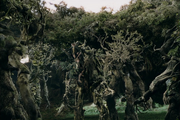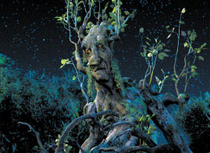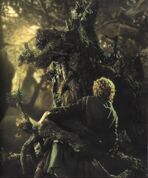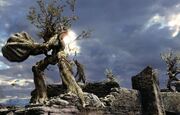- "We must not be hasty."
- —Treebeard in The Two Towers
Ents, called Onodrim (Tree-host) by the elves, are a very old race that appeared in Middle-earth at the same time that the elves did. They were apparently created by Eru Ilúvatar at the behest of Yavanna after she learned of Aulë's children, the Dwarves, knowing that they would want to fell trees. Ents were envisioned as Shepherds of the Huorns, to protect the forests from orcs and other perils. The Elves have tales of teaching the trees and the Ents to talk: although the Ents were sentient beings at the time, they did not know how to speak until the Elves taught them. Treebeard spoke of the Elves "curing the Ents of their dumbness" that it was a great gift that could not be forgotten ("always wanted to talk to everything, the old Elves did").
In The Two Towers, Chapter 5, "The White Rider", Gandalf calls Treebeard, "...the oldest living thing that still walks beneath the Sun upon this Middle-earth." In The Return of the King, Chapter 6, "Many Partings", Celeborn addresses Treebeard as "Eldest."
Ents are tree-like creatures, having become more and more like the trees that they herded. They vary in traits, from everything to height and size, colouring, and the number of fingers and toes. An individual Ent more or less resembles the specific species of tree that they typically guard. For example, Quickbeam guarded Huorns and thus looked very much like a Huorn (tall and slender, etc.). Ents are very strong, as recounted by Merry and Pippin: "their punches can crumple iron like tinfoil, and they can tear apart solid rock like breadcrusts." In the Third Age of Middle-earth, the forest of Fangorn was apparently the only place Ents still inhabited, although the Huorns may still have survived elsewhere, as in the Old Forest.
History

A group of Ents with Treebeard, the eldest Ent, in the center. From Peter Jackson's The Two Towers.
Almost nothing is known of the early history of the Ents — they apparently lived in and protected the large forests of Middle-earth in previous ages, and they briefly appear near the end of the First Age, attacking a band of Dwarves, apparently summoned by Beren and Lúthien. Treebeard told of a time when apparently all of Eriador was one huge forest and part of his domain, but these immense forests were cut by the Númenóreans of the Second Age, or destroyed in the calamitous War of the Elves and Sauron of the 17th century of the Second Age. Treebeard's statement is also supported by remarks Elrond the half-elf made at the Council of Elrond. Elrond said that "Time was once when a squirrel could carry a nut from tree to tree from Rivendell to the Great Sea...", further indicating that all of Eriador was once a single vast primeval forest, of which Fangorn Forest was just "the Eastern End of it" according to Treebeard.
Treebeard boasted to Merry and Pippin about the strength of the Ents. He said that they were much more powerful than Trolls, which Morgoth(in the Elder Days or First Age) supposedly made as imitations of the Ents, but did not come near to their power. He compares this with how orcs were Morgoth's imitation of elves. There used to be Entwives (literally "Ent-women"), but they started to move farther away from the Ents because they liked to plant and control things, so they moved away to the region that would later become the Brown Lands across the Great River Anduin. This area was destroyed by Sauron, and the Entwives disappeared. The Ents looked for them, but have never found them. It is sung by the Ents that one day they will find each other, when they lose all else. In the Fellowship of the Ring, Sam Gamgee says his cousin Hal saw a walking tree in the north of the Shire. When Pippin and Merry tell Treebeard about the Shire, Treebeard says the Entwives would like that land, suggesting Hal saw either an Entwife or a Huorn. What exactly happened to the Entwives was something Tolkien wanted to keep a mystery, even to himself, but in one of his letters he said, "I think that in fact the Entwives have disappeared for good, being destroyed with their gardens in the War of the Last Alliance."[1]

An Ent shepherd of Fangorn Forest
Evidence of the origin of the Ents can be found in the Valaquenta, in an exchange between Yavanna (a queen of the Valar, "...lover of all things that grow in the earth.") and Manwë ("...the first of all Kings: lord of the realm of Arda."), after Yavanna's spouse Aulë secretly endeavors to create the Dwarves. Aulë reminds her that the children of Ilúvatar (Elves, Men and now Dwarves) will exploit her creations for their own benefit, "though not without respect and gratitude." The defenselessness of her realm moves Yavanna to plead with Manwë: "My heart is anxious, thinking of the days to come. All my works are dear to me... Shall nothing that I have devised be free from the dominion of others?” Manwë responds by asking, of all she holds dear, what she would have preserved against exploitation, and she answers: "...the kelvar can flee or defend themselves, whereas the olvar that grow cannot. And among these I hold trees dear... Would that the trees might speak on behalf of all things that have roots, and punish those that wrong them!” Manwë, while deliberating, is overcome by a vision of the music of the Ainur, and grants her request: "Behold! When the Children awake, then the thought of Yavanna will awake also, and it will summon spirits from afar, and they will go among the kelvar and the olvar, and some will dwell therein, and be held in reverence, and their just anger shall be feared." Yavanna returns to her spouse Aulë and reports: "Eru is bountiful. Now let thy children beware! For there shall walk a power in the forests whose wrath they will arouse at their peril." He responds ominously: "Nonetheless they will have need of wood."

Treebeard grabbing Pippin.
In The Two Towers, the second volume of Tolkien's The Lord of the Rings, the Ents—usually very patient, deliberate beings—do become angry at Saruman, whose armies are cutting down (in their eyes, killing) large numbers of their trees.They convene an Entmoot, a meeting of the Ents of Fangorn Forest at Derndingle to discuss the argument of going to war.
The Last March of the Ents, as depicted in Peter Jackson's The Two Towers.
After lengthy deliberation (though from the perspective of the Ents, this is very quick action), they come to the conclusion: (in the book) to destroy Isengard, and head toward it. They are led by Treebeard, the oldest Ent, and accompanied by the Hobbits Meriadoc Brandybuck and Peregrin Took. They destroy Isengard in an all-out assault and trap Saruman in the tower of Orthanc.
During the Ents' assault on Isengard they destroyed the dams built by Sarumans minions and therefore flooded the place.
After that they moved many of their trees there and the place became known as the Watchwood.
Language
Ents are not hasty creatures, they take their time; even their language is "unhasty". In fact, their language appears to be based on an ancient form of Common Eldarin, later enriched by Quenya and Sindarin, although it includes many unique 'tree-ish' additions. There are actually two different languages:
- Old Entish. Originally, the Ents had a language of their own, described as long and sonorous; it was a tonal language (like Chinese). It is unknown if a non-Ent could even pronounce Old Entish correctly: it was filled with many subtle vowel shades, and was very longwinded. Only Ents spoke Old Entish; not because they kept their language a secret, as the Dwarves did with Khuzdul, but because no other could master it. It was quite an alien language to all others. The Huorns and trees of Fangorn forest could understand Old Entish and converse with the Ents and each other with it. The only extant sample, a-lalla-lalla-rumba-kamanda-lindor-burúme, the word for hill (or possibly even just part of the name of a specific hill), was described as a very inaccurate sampling. Even the Elves, master linguists, could not learn Old Entish, nor did they attempt to record it due to its complex sound structure. The grammar structure of Old Entish was also quite bizarre, often described as a lengthy, long-winded discussion of a topic. There may not even have been a word for yes and no: such questions would be answered by a long monologue on why the Ent in question did or did not agree with the Ent who asked the question. The Ent Quickbeam was regarded as a very "hasty" Ent for answering a question before another Ent had finished: the end may only have been another hour away. Ents as a rule would say nothing in Old Entish unless it was worth taking a long time to say. For everyday language function, they usually resorted to "New" Entish.
- "New" Entish (Never named as such in the text). Due to contact with the Elves, the Ents learned much from them. The Ents found the Elvish language Quenya to be a lovely language, and adapted it after their fashion to everyday use. However, they basically adapted Quenya vocabulary to Old Entish grammatical structure. Thus, unlike Old Entish, the individual words of "New Entish" that characters such as Treebeard spoke were easily translatable. However, in context they formed lengthy run-on sentences of redundant adjectives that could still stretch well over an hour in length. For example, when Treebeard essentially wanted to tell Merry and Pippin, "There is a shadow of the Great Darkness in the deep dales of the forest", he literally said in New Entish "Forest-golden-leaves, deep-dales-winter, forest-many-shadowed, deep-valley-black". Unlike Old Entish, a non-Ent conceivably could speak "New" Entish. Even when speaking the Common Speech, Westron, Ents fell into the habit of adapting it into their grammatical structure of repeating compound adjectives used to express fine shades of meaning.
The Elvish name for Ents is Onodrim, singular Onod.

Attack of the Ents
Tolkien later noted that the destruction of Isengard by the Ents was based on his disappointment in Macbeth; when "Birnham Wood is come to castle Dunsinane", Tolkien was less than thrilled that it amounted to men walking on stage with leaves in their hats. He decided that when he did that scene for himself, he'd do it right.
Statue
There are plans to erect a statue of Treebeard, by Tim Tolkien, J.R.R.'s great-nephew, near the latter's former home in Moseley, Birmingham.
Etymology
The word "Ent" was taken from Anglo-Saxon, where it means "giant". Tolkien may have extracted the word from the Anglo-Saxon poetry fragments orþanc enta geweorc = "work of cunning giants" and eald enta geweorc = "old work of giants", which described Ancient Roman ruins; see Orthanc. In this sense of the word, Ents are probably the most ubiquitous of all creatures in fantasy and folklore, perhaps second only to Dragons. The word Ent, as it is historically used, can refer to any number of large, roughly humanoid creatures, including, but not limited to, giants, trolls, orcs, and even Grendel from the poem Beowulf.
In this meaning of the word, Ents are one of the staples of fantasy and folklore/mythology, alongside wizards, knights, princesses, and dragons, although modern English-speakers would probably not call them by their traditional name.
Tolkien's Ents are very different from traditional Ents, appearing as humanoid trees. They appear to have been inspired by the talking trees of many of the world's folklores. See Wikipedia's tree mythology article for more information.
As with Hobbit, Ent is a term that in modern times is almost exclusively connected with J.R.R. Tolkien, and the usage of the term seldom evokes in people its earlier meanings.
Tolkien-like Ents in non-Tolkien fiction
- In fantasy and role-playing games such as Dungeons & Dragons, EverQuest, Magic: The Gathering, and the Warcraft PC game series, Tolkien-like Ents are known as Treants or Treefolk, for copyright reasons (much like Hobbits are only referred to as Halflings in Dungeons & Dragons and EverQuest).
- In the video game Dota 2, Treant Protector's appearance, name, and voice are based heavily on Treebeard, the eldest of the Ent race.
- Tolkien-like Ents are also depicted in the MMORPG of RuneScape (in the form of Spirit Trees planted by gnomes), as well as the real-time strategy game Myth: The Fallen Lords. In all their incarnations, these tree-people are very close in spirit to their Tolkien-esque forebears, although Dungeons & Dragons has also explored the concept of corrupt trees and tree-like monsters (akin to Old Man Willow and the huorns of Fangorn).
- Somewhat akin to Ents are the Ancients portrayed in the Warcraft universe.
- In the Dragon Age seriesm there are tree-like creatures called Sylvans, but these are simply trees possessed by malevolent spirits.
- In the video game Okami, there are cursed trees that attack by throwing poisonous fruit. However, these trees are merely possessed by dark magic and return to being normal trees once bloomed with the celestial brush.
- In the Harry Potter series, the Whomping Willow is a tree that seems to have a mind of its own and will attack anything that comes near it.
- A tree-like Jedi appears in the Star Wars: Young Jedi Knights novels.
- The species that the Jedi belonged to, the Neti, were a species of tree-like shapeshifters that could assume their true, more tree-like form or a more Humanoid form.
- C.S. Lewis, one of Tolkien's friends, included sentient trees in his Chronicles of Narnia. Treebeard, however, was based upon Lewis himself.
- A game called Heroes of Might and Magic III uses Tolkien-like Ents, called Dendroids, as units that one can use in battle.
- In The Wheel of Time series, the being known as Someshta "The Green Man", a Nym, is very similar to an Ent in both appearance and attitude, in that he was a guardian of greenery in the story and his people worked to bring plants and trees to greater life.
- In the MMORPG Realm of the Mad God, Ents, Ent Ancients, and Ent gods are all monsters that you can fight.
- In the Elder Scrolls series, Spriggans bear some resemblance to Ents; e.g., being made of tree bark, having the ability to blend into or with trees and forests, and being considered by many as the guardians of Tamriel's forests.
- In the film Maleficent (2014), a tree army similar to Ents defend the homeland of the fairies when humans come to take the riches that are held in their kingdom.
- The Marvel character Groot bears many similarities to Ents.
References
- ↑ J. R. R. Tolkien, The Letters of J. R. R. Tolkien, Carpenter, Humphrey with Christopher Tolkien, ed. Boston: George Allen & Unwin/Houghton Mifflin (1981). ISBN 0-04-826005-3.
|
Races of Arda
Ainur | Dwarves | Elves | Ents | Great Eagles | Hobbits | Huorns | Men | Petty-dwarves | Skin-changers (Beornings) Servants of the Shadow:
Barrow-wights | Ettens | Dragons (Fire-drakes and Cold-drakes) | Ogres | Orcs | Spiders | Trolls | Úmaiar | Úvanimor | Vampires | Wargs | Werewolves |
